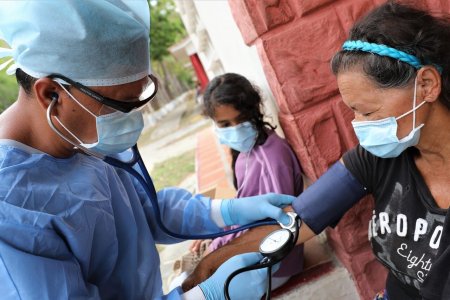- October 13, 2021
- Posted by: humanitarianweb
- Category: Humanitarian News

The Global Fund to Fight AIDS, Tuberculosis and Malaria announces it has awarded to date a total of US$4 billion to more than 100 low- and middle-income countries to fight COVID-19, adapt HIV, TB and malaria programs, and urgently reinforce fragile systems for delivering health services. This funding is on top of the over US$4.2 billion a year the Global Fund provides to countries to fight HIV, TB and malaria.
Since March 2021, when new funding became available thanks to the support of donors led by the United States, followed by Germany, the Netherlands and Switzerland, the Global Fund has awarded US$3 billion for COVID-19 through its COVID-19 Response Mechanism (C19RM), created by the Global Fund in March 2020. This builds on the US$1 billion funding the Global Fund approved for the COVID-19 response in 2020.
“The Global Fund’s ability to act swiftly and at scale to support countries’ COVID-19 responses reflects the power and the agility of the Global Fund partnership. We have been supporting countries to meet the new challenges posed by the pandemic in 2021, including surges in infections and deaths driven by the Delta variant, acute oxygen shortages and the need to support vaccine rollout through strengthening systems for health,” said Peter Sands, Executive Director of the Global Fund. “Our recent Results Report demonstrated how badly COVID-19 has impacted HIV, TB and malaria programs. Yet, without the rapid and determined actions that took place across the Global Fund partnership to mitigate the impact of COVID-19 on the three diseases, it would have been much worse.”
The Global Fund’s extensive health and community networks and established health procurement and distribution system are well suited to distribute new COVID-19 tools, medical supplies and training at scale in more than 100 countries. Commodities procured with C19RM funding – including lifesaving PPE, treatments including oxygen and diagnostic tests – are being distributed and having an impact. C19RM priorities and investments have been coordinated with partners through the Access to COVID-19 Tools (ACT) Accelerator.
However, despite the progress countries are able to achieve with this support, the Global Fund will run out of C19RM funding this month. Without further funding, the Global Fund will no longer be able to support countries as they seek to protect their front-line health workers, scale up testing to stop the spread of the pandemic, and provide severely ill patients with life-saving treatments including medical oxygen.
“Since the Global Fund is the primary provider of financial support for many low- and middle-income countries for all the non-vaccine components of their COVID-19 responses, this means countries will need to scale back just when they need to be scaling up,” said Peter Sands. As part of ACT-Accelerator’s overall appeal, the Global Fund is seeking to secure an additional US$6.3 billion to respond to the most immediate and urgent needs in the global fight against COVID-19.
In terms of interventions funded, the US$3 billion in 2021 included:
- US$678 million (22%) to procure diagnostic tests that are crucial to containing the spread of COVID-19 and to detecting the emergence of variants,
- US$524 million (17%) to procure personal protective equipment (PPE) to protect health workers and thus ensure the continued viability of health systems,
- US$499 million (17%) to support countries facing serious oxygen shortages with higher output oxygen solutions.
In May 2021, the Global Fund swiftly supported Kenya to respond to oxygen shortages and procure oxygen products, including cylinders and necessary accessories (regulators, flowmeters and humidifiers), Pressure Swing Adsorption oxygen plants, as well as bulk liquid oxygen. In Uganda, which experienced a surge in cases in June, the Global Fund helped procure diagnostic tests and protective equipment to contain the epidemic through prevention and control measures and mitigate the spread of COVID-19 in health facilities, institutions and communities. In Eswatini, HIV prevention services for adolescent girls and young women were maintained thanks to community peer educators moving these services online.
The Global Fund’s COVID-19 Response Mechanism follows a country-led, inclusive, and demand-driven approach to ensure funding goes where it is most needed. “We commend the commitment that implementing countries and partners have shown to present high quality funding requests so the funds awarded can achieve impact against COVID-19,” said Rahul Singhal, Chief Risk Officer and Chair of C19RM Investment Committee at the Global Fund. “But the work has only just started. We will now need to focus on supporting implementation and strengthening the impact of grant investments.”
The Global Fund also helped create the Access to COVID-19 Tools (ACT) Accelerator, the global collaborative partnership turbocharging the global pandemic response, and is the primary channel for funding and procurement across the coalition’s Therapeutics and Diagnostics pillars, as well as the Health Systems Connector. The Global Fund is a key partner in the ACT-Accelerator’s COVID-19 Oxygen Emergency Taskforce and is one of the main funding sources for the procurement of medical oxygen. To date, the ACT-Accelerator has procured more than 109 million tests, distributed lifesaving dexamethasone treatment and oxygen and procured personal protective equipment (PPE) worth more than US$830 million to protect front-line health workers.
To defeat COVID-19, the Global Fund advocates for a comprehensive approach that brings together testing, treatments, vaccines and the health systems to make it happen – vaccines alone will not be enough. Until vaccines are made available worldwide and as variants of concern continue to emerge across the globe, the best strategy to fight COVID-19 is to test, trace, treat and isolate, which requires hundreds of millions of tests, effective new treatments, and training and PPE for health care and laboratory workers.
